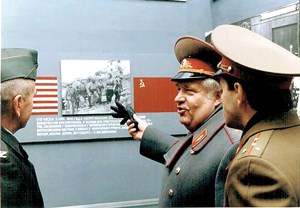Bridget Wingert: Happy to Be Here -- A peaceful warrior in our midst

A Russian officer briefs Colonel David R. Kiernan during a tour of Russia after the fall of the Berlin Wall.
Bridget Wingert (Bucks County Herald)
By Bridget Wingert (PA - Bucks County Herald)
David R. Kiernan looked like a leader way back in the 1950s. He was class president at his Catholic school on Long Island every year starting in seventh grade and then student council president for his senior year in high school.
And he showed tenacity. Commissioned as an Army lieutenant along with 25,000 others in 1966, he was one of only 325 promoted to colonel in 1990. He retired from the Army after 26 years, including the Cold War, Vietnam and the Gulf War. He had lived in seven states and four countries in a rise from combat to communications director.
Then his civilian career began and all of his experiences came into play. “No amount of schooling,” he said in his recently published memoir, “could provide the knowledge and flexibility he acquired in the Army.”
“The Best Is Yet to Come, a Memoir of a Peaceful Warrior” is Kiernan’s story, outlining events in chronological order.
Kiernan’s first deployment after graduating from Virginia Military Institute was defending the West German border near the former Dachau Concentration Camp after the East German invasion of Czechoslovakia. A year later he was in Vietnam as a military advisor, part of a team of military, State Department and CIA personnel working with Vietnamese soldiers. He lived with a local family in austere conditions – they were resilient “like bamboo” family members said.
In 1970 Kiernan was back in the United States, at Fort Jackson, S.C., training soldiers for Vietnam deployment. Here he coordinated the first Special Olympics competition with Eunice Kennedy Shriver. Athletes were housed in empty barracks and the soldiers made an on-the-spot audience to cheer along with families in the sporting events.
Next Kiernan was a high school ROTC instructor at a military academy in Missouri, where he led drill team and recruited cadets.
When he moved to Fort Wainwright in Alaska, Kiernan put his college major, English, to work. He was promoted to major and became the public affairs officer, working with journalists from the Fairbanks News-Miner and editing the post newspaper, The Yukon Sentinel. “As editor in chief of a weekly newspaper, I learned the urgency of the deadline in filling the news hole,” Kiernan wrote.
From cold Alaska to warm Fort Benning, Ga., came next, and the 29th Infantry. Kiernan was appointed editor of Infantry Magazine, the oldest military journal of the Department of Defense.
Back at Fort Jackson from 1983 to 1985, Kiernan was now public affairs officer and he was a lieutenant colonel, serving as infantry training officer and he was on hand for the dedication of the Ernie Pyle Media Center, named for the World War II journalist. Kiernan had the unusual duty of assisting the University of South Carolina in transferring 27 million feet of silver nitrate Movietone Newsreel into bunkers for preservation.
At age 43, he trained at Fort Bragg as a paratrooper with 18th Airborne Corps and earned the right to wear the signature maroon beret. Life was different at the Pentagon where Kiernan was transfered next, in 1989. He wrote, “17 miles of hallway and 27,000 military and civilian employees.” He was promoted to colonel and was the Army spokesperson for the Division Chief for Media Relations.
At the Pentagon, he worked with journalists from radio, television and newspapers, an experience that prepared Kiernan for Saudi Arabia as spokesman for Gen. Norman Schwarzkopf during Operation Desert Shield.
Kiernan was sent to Russia after the fall of the Berlin Wall and the dissolution of the Soviet Union as part of a team of advisors on generating a free press. A winner of several combat medals, Kiernan was the chief Army emissary on a peace mission in a time of hope. He was impressed by the soldiers he met – well educated, “a giving people.”
Col. Kiernan made a final report on the mission to Secretary of Defense Dick Cheney. Kiernan wondered then what Russia’s relation to Ukraine would become.
Kiernan’s final Army assignment was Hawaii as chief of public affairs for U.S. Army Pacific. But leaving the military was just the beginning of a full civilian life.
He called the third section of his memoir “The Harvest Years.” Each section includes Events and Lessons Learned.
Applying lessons from his organizational experiences, Kiernan directed press operations for the Atlanta Olympics is 1996. “The daily experience of working side-by-side with former Olympic athletes gave me an appreciation of the selfless sacrifice,” Kiernan wrote.
Everything he had done before made Kiernan ready for his next career, joining a private company, Military Professional Resources Incorporated (MPRI). He was senior vice president for strategic communications and corporate spokesman for military contractors from 42 countries assisting emerging democracies. With MPRI he would be involved in education, at the Defense Information School and colleges around the country.
“Our small corporate staff grew from 25 personnel at its origin to 4,000 employees in 15 years,” Kiernan wrote. “Our first contract in Bosnia grew to 432 contracts in 42 countries by 1996 ...”
Kiernan has written another book, “Headlines from the Frontline,” about the relationship between the media and the military. He is participating in planning for a Desert Storm Memorial in Washington (the 30th anniversary is this year) and he is on the committee creating the Bucks County Vietnam War Memorial in Penndel. The 50th anniversary of withdrawal of American troops from Vietnam is in 2023.
“Colonel Rick” Kiernan and his wife, Susan, live in Warminster today, close to grandchildren.
“The Best Is Yet to Come” is available in paperback and digital versions at Amazon.com.
Tags:
Back